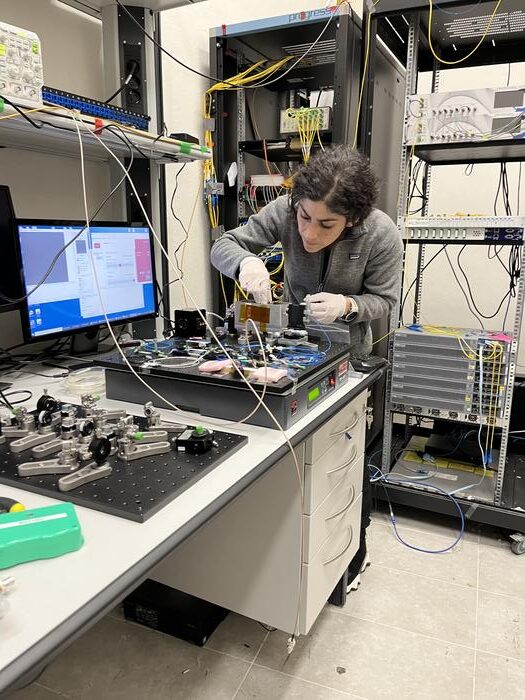In a groundbreaking advancement that promises to reshape the future of precision timekeeping and high-capacity telecommunications, researchers have successfully demonstrated the transmission of ultrastable optical frequency signals from optical atomic clocks over tens of kilometers of deployed multicore optical fiber. This pivotal breakthrough signifies the compatibility of these ultrastable signals with existing telecommunications infrastructure, heralding a new era where state-of-the-art atomic clocks can be interconnected through fiber networks without compromising data traffic or signal integrity.
The intrinsic complexity of modern data networks demands ever-higher throughput capacities, and multicore fiber technology has emerged as a remarkable solution by embedding multiple light-guiding cores within a single fiber strand. Each of these cores can independently carry data, drastically multiplying bandwidth capabilities compared to the traditional single-core fibers. This enhanced capacity is vital for data-intensive applications, including streaming media, financial transactions, and artificial intelligence computations, all of which hinge upon uninterrupted and rapid data flow.
Yet beyond these commercial uses lies a tantalizing scientific prospect: the ability to link ultra-precise optical atomic clocks distributed geographically by leveraging multicore fiber networks. Optical atomic clocks currently represent the pinnacle of timekeeping precision, boasting frequency stabilities necessitating representation out to 18 decimal places. They are crucial not only for redefining the international standard of the second but also for conducting sophisticated experiments in fundamental physics and improving global positioning systems.
.adsslot_ynAQB35TYz{ width:728px !important; height:90px !important; }
@media (max-width:1199px) { .adsslot_ynAQB35TYz{ width:468px !important; height:60px !important; } }
@media (max-width:767px) { .adsslot_ynAQB35TYz{ width:320px !important; height:50px !important; } }
ADVERTISEMENT
The principal challenge in transmitting optical clock signals over fiber optic cables arises from the sensitivity of optical fibers to environmental perturbations such as temperature fluctuations and mechanical strain. These disturbances introduce detrimental noise, manifesting as frequency instability that can obscure the ultrastable signals required for high-precision applications. To overcome these hurdles, bidirectional transmission of light within fibers has traditionally been employed, enabling real-time noise sensing and adaptive correction.
However, bidirectional communication in conventional fiber optic networks engenders its own obstacles. Such networks typically operate with separate fibers for sending and receiving data to avoid noise-inducing reflections and signal degradation. Prior experiments to transfer ultrastable frequencies therefore relied heavily on “dark fibers,” unused fibers devoid of conventional data traffic, or on specialized equipment capable of facilitating bidirectional transmission within a single core—both approaches presenting practical and economic limitations.
In an innovative departure from these constraints, the research team conceived a method exploiting the distinctive characteristics of multicore fibers. Since the multiple cores housed in a single fiber experience environmental disturbances almost identically, outbound optical clock signals can be routed through one core, while the returning signals traverse another core. This scheme preserves the benefits of bidirectional noise correction techniques without the drawbacks of reflections or interference that hinder single-core fibers, all while permitting the coexistence of active telecommunications data traffic.
This novel approach was rigorously tested in an operational multicore fiber testbed situated in L’Aquila, Italy. Using approximately 25 kilometers of deployed multicore fiber, the researchers meticulously quantified the fractional frequency instability of transmitted optical signals. Their measurements revealed a remarkable stability level of 3 × 10⁻¹⁹ over a near three-hour period, solidly within the stringent bounds demanded by current optical clocks. These results validate that multicore fibers do not inherently degrade signal stability as compared to traditional single-core fibers, even when carrying telecommunications traffic simultaneously.
The implications of this technology are profound. Linking precision optical clocks across metropolitan regions and potentially intercontinental distances could catalyze significant advances in fundamental physics research, such as tests of general relativity or searches for variations in fundamental constants. Moreover, establishing an ultrastable optical frequency network could precipitate a global redefinition of the second, bolstering synchronization in navigation systems and international time dissemination.
Notably, this research underscores the synergy between telecommunications infrastructure advancements and fundamental science. The continued commercial deployment of multicore fiber technology—spurred by the insatiable global appetite for data—enables scientists to repurpose existing fiber assets for next-generation time-frequency transfer applications. The collaborative effort bridging NIST, Nokia Bell Labs, Japanese industrial leader Sumitomo Electric Industries, and academic institutions in the United States and Italy embodies a successful model for multidisciplinary innovation.
While the current demonstrations are limited to medium-scale fiber lengths without optical amplification, the research team acknowledges critical challenges ahead. Fiber links exceeding around 80 kilometers require optical amplifiers to sustain signal strength, and the compatibility of amplification techniques with ultrastable frequency transfer remains an active area of investigation. Continued efforts will focus on integrating amplification without sacrificing the exceptional stability achieved thus far.
The experimental setup capitalized on the principle that environmental noise affects all cores of a multicore fiber nearly identically, allowing noise compensation algorithms to exploit this property effectively. This concept represents a significant technical advance over previous approaches necessitating dark fibers or complex bidirectional hardware, potentially accelerating the practical deployment of high-fidelity optical clock networks integrated with vast telecommunications backbones.
As the team advances toward demonstrating long-haul transmission with optical amplification and extended multicore fiber spans, the scientific community eagerly anticipates the realization of interconnected, continent-spanning optical clock networks. Such networks promise not only to enhance measurement science but also to catalyze future technologies rooted in time synchronization and quantum communication.
Subject of Research: Ultrastable optical frequency transfer utilizing multicore fiber compatible with telecommunication data transmission.
Article Title: Ultrastable optical frequency transfer and attosecond timing in deployed multicore fiber
News Publication Date: 19-Jun-2025
Web References:
https://doi.org/10.1364/OPTICA.558821
https://opg.optica.org/optica/home.cfm
References:
N. Hoghooghi, M. Mazur, N. Fontaine, Y. Liu, D. Lee, C. McLemore, T. Nakamura, T. Hayashi, G. Di Sciullo, D. Shaji, A. Mecozzi, C. Antonelli, F. Quinlan, “Ultrastable optical frequency transfer and attosecond timing in deployed multicore fiber,” Optica, vol. 12, pp. 894-899, 2025.
Image Credits: Franklyn Quinlan, NIST
Keywords
Atomic clocks, Technology, Fibers, Physics
Tags: bandwidth capabilities of multicore fibersdata-intensive applications in telecommunicationsfuture of data transmission technologieshigh-capacity telecommunicationsinterconnecting atomic clocks through fiber networksmulticore optical fiber technologyoptical atomic clock frequency stabilityprecision timekeeping advancementsscientific prospects of optical clock networkingtelecommunications infrastructure compatibilityultraprecise optical clocksultrastable frequency signal transmission





